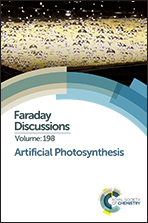CuAAC-based assembly and characterization of a ruthenium–copper dyad containing a diimine–dioxime ligand framework†
Abstract
The design of molecular dyads combining a light-harvesting unit with an electroactive centre is highly demanded in the field of artificial photosynthesis. The versatile Copper-catalyzed Azide–Alkyne Cycloaddition (CuAAC) procedure was employed to assemble a ruthenium tris-diimine unit to an unprecedented azide-substituted copper diimine–dioxime moiety. The resulting RuIICuII dyad 4 was characterized by electrochemistry, 1H NMR, EPR, UV-visible absorption, steady-state fluorescence and transient absorption spectroscopies. Photoinduced electron transfer from the ruthenium to the copper centre upon light-activation in the presence of a sacrificial electron donor was established thanks to EPR-monitored photolysis experiments, opening interesting perspectives for photocatalytic applications.
- This article is part of the themed collection: Artificial Photosynthesis

 Please wait while we load your content...
Please wait while we load your content...